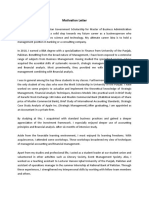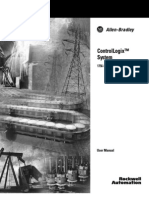References
References
Uploaded by
api-216117878Copyright:
Available Formats
References
References
Uploaded by
api-216117878Original Title
Copyright
Available Formats
Share this document
Did you find this document useful?
Is this content inappropriate?
Copyright:
Available Formats
References
References
Uploaded by
api-216117878Copyright:
Available Formats
Adorno, T. W., Frenkel-Brunswick, E., Levinson, D. J., & Sanford, R. N. (1950). The authoritarian personality.
New York: Harper & Row. Allport, G. W. (1954). The nature of prejudice. Reading, MA: Addison-Wesley. Altemeyer, B. (1988). Enemies of freedom: Understanding right-wing authoritarianism. San Francisco: Jossey-Bass. Bairoh, S. (2007). Current debates on classifying diversity management: Review and a proposal. Meddelanden working papers. Helsinki, Finland: Retrieved from https://helda.helsinki.fi/bitstream/handle/10227/267/534-978-951-555-978-4.pdf?sequence=2 Cole, J. (n.d.). Beyond prejudice: Understanding prejudicial behavior. Retrieved from http://www.beyondprejudice.com Devine, P. G. (1995). Prejudice and Out-Group Perception. In A. Tesser (Ed.), Advanced Social Psychology (pp.467-524). New York, NY: McGraw-Hill. Dietz, J., & Peterson, L. E. (2006). Diversity management. In G. Stahl & I. Bjrkman (Eds.), Handbook of research in international human resource management (pp. 223-244). Edward Elgar Publishing Limited, UK. Duggan, T. (2013). How organization theories explain the dynamic of the diverse workplace. Retrieved from http://smallbusiness.chron.com/organization-theories-explain-dynamic-diverseworkplace-16662.html Guerin, L., & DelPo, A. (2011). The Essential Guide to Federal Employment Laws. Berkeley, CA: Nolo. Hewstone, M., Rubin, M., & Willis, H. (2002). Intergroup bias. Annual Review of Psychology, 53, 575-604. Hogg, M. A., Terry, D. J., & White, K. M. (n.d.). A tale of two theories: A critical comparison of identity theory with social identity theory (1995). Social Psychology Quarterly, 58(4), 255-269. Retrieved from http://www.communicationcache.com/uploads/1/0/8/8/10887248/a_tale_of_two_theories_a_critical_comparison_of_identity_theory_with_social_identity_theory.pdf Kinder, D.R., & Sears, D.O. (1981). Prejudice and politics: Symbolic racism versus racial threats to the good life. Journal of Personality and Social Psychology, 1, 95-109. Levine, R. A., & Campbell, D. T. (1972). Ethnocentrism: Theories of conflict, ethnic attitudes and group behavior. New York: Wiley. Litvin, D. R. (1997) The discourse of diversity: From biology to management. Organization, 4: 187209. Lorbiecki, A., & Jack, G. (n.d.). Critical turns in the evolution of diversity management. (2000). British Journal of Management, 11(3), S17-S31.
Mannix, E. A., & Neale, M. A. (2006). What differences make a difference? The promise and reality of diverse teams in organizations. Psychological Science in the Public interest, 6, 31-55. McCormick, K. (2007, February ). The evolution of workplace diversity. Dallas 15th annual advanced employment law course, Dallas. Retrieved from http://www.texasbarcle.com/Materials/Events/6369/4079_01.pdf Mor Barak, M. E. (2005). Managing Diversity Toward a Globally Inclusive Workplace. Thousand Oaks, CA: Sage Publications. Multicultural work force. (n.d.). Retrieved from http://www.referenceforbusiness.com/small/MailOp/Multicultural-Work-Force.html Myrdal, G. (1944). An American dilemma. New York: Harper & Row. Organization theory. (2011). Retrieved from http://www.publicorgtheory.org/organization-theory.html Pettigrew, T. F., Christ, O., Wagner, U., & Stellmacher, J. (2007). Direct and indirect intergroup contact effects on prejudice: A normative interpretation. International Journal of Intercultural Relations, 31, 411-425. Prasad, P., Pringle, J. K., & Konrad, A. M. (2006). Examining the contours of workplace diversity: concepts, contexts and challenges. In Handbook of Workplace Diversity (pp. 1-22). Sage Publications. Rokeach, M. (1973). The nature of human values. New York: Free Press. Sears, D.O., & Kinder, D.R. (1985). Whites' opposition to busing: On conceptualizing and operationalizing group conflict. Journal of Personality and Social Psychology, 48, 1141-1147. Spears, R.; Oakes, P.J.; Ellemers, N. et al. The social psychology of stereotyping and group life (Oxford: Blackwell): 119143. Stevens, F. G., Plaut, V. C., & Sanchez-Burks, J. (2008). Unlocking the benefits of diversity: All-inclusive multiculturalism and positive organizational change. The Journal of Applied Behavioral Science, 44, 116-133. doi:10.1177/0021886308314460 Stockdale, M. S., & Crosby, F. J. (Eds.). (2004). The Psychology and Management of Workplace Diversity. Malden, MA: Blackwell Publishing. TeamSweat. (2011, July 28). Nike Sweatshops Behind the Swoosh [Video file]. Retrieved from http://www.youtube.com/watch?v=M5uYCWVfuPQ Thomas, D. A. (2004). Diversity as strategy. Harvard Business Review, 82(9), 98-108. Thomas, D. E., & Ely, R. J. (1996). Making differences matter: A new paradigm for managing diversity. Harvard Business Review, 74(5), 79-90.
Training Film & Video Association. (2005). Diversity, Making it Work: Peter Quarry interviews Edward Hubbard [DVD]. United States: Insight Media. Training Point. (2008). Overcoming Personal Barriers to Diversity. [DVD]. United States: Insight Media. Turner, J., & Oakes, P. (1986). The significance of the social identity concept for social psychology with reference to individualism, interactionism and social influence. British Journal of Social Psychology, 25(3), 237252. Yang, Y., & Konrad, A. M. (2011). Understanding diversity management practices: Implications of of institutional theory and resource-based theory. Group & Organizational Management, 36(1), 638. doi: 10.1177/105960111039099.
You might also like
- Apa Citation Style 8th Edition PDFDocument1 pageApa Citation Style 8th Edition PDFCarlos Anderson88% (26)
- APA 8TH EditionDocument2 pagesAPA 8TH EditionEunice Candelario86% (14)
- (Connecting Content and Kids) Carol Ann Tomlinson, Jay McTighe-Integrating Differentiated Instruction & Understanding by Design-ASCD (2006) PDFDocument209 pages(Connecting Content and Kids) Carol Ann Tomlinson, Jay McTighe-Integrating Differentiated Instruction & Understanding by Design-ASCD (2006) PDFLorena Cartagena Montelongo100% (5)
- The Biological Foundations of Organizational BehaviorFrom EverandThe Biological Foundations of Organizational BehaviorStephen M. ColarelliNo ratings yet
- Readings For Social PsychologyDocument11 pagesReadings For Social PsychologySebastian DeterdingNo ratings yet
- Suggested ReadingsDocument5 pagesSuggested ReadingsSindhu BrahmaNo ratings yet
- References - Basic Statistics Tales of Distributions (9th Edition)Document6 pagesReferences - Basic Statistics Tales of Distributions (9th Edition)LintangFakhruParadhatuNo ratings yet
- Social Psychology SyllDocument10 pagesSocial Psychology Sylldinu_adercaNo ratings yet
- References 2 eDocument69 pagesReferences 2 eArnab ChoudhuryNo ratings yet
- The Books in The OD "Bible": Organization-Development-Part-1-Of-6-Prehistoric-OdDocument3 pagesThe Books in The OD "Bible": Organization-Development-Part-1-Of-6-Prehistoric-OdmustamuNo ratings yet
- Konstruksi Alat..., Masitah, Fpsi Ui, 2012Document5 pagesKonstruksi Alat..., Masitah, Fpsi Ui, 2012JoenAselirembangNo ratings yet
- Zenker and Fischer 2010 Bibliography of Conductive Arguments - V - 1 - 1Document5 pagesZenker and Fischer 2010 Bibliography of Conductive Arguments - V - 1 - 1Lucrecia BorgiaNo ratings yet
- F4 4-IntergroupBiasesDocument2 pagesF4 4-IntergroupBiasesMircea DragosNo ratings yet
- ResumDocument16 pagesResumm.thoriq.h.aNo ratings yet
- Daftar PustakaDocument4 pagesDaftar Pustakaguinevere_honeyNo ratings yet
- Indian Institute of Management Kashipur Fellow Programme in Management (2021-22)Document6 pagesIndian Institute of Management Kashipur Fellow Programme in Management (2021-22)Vaishnavi GautamNo ratings yet
- 21 BiblioDocument84 pages21 BibliokrisztiszanNo ratings yet
- OpenAccess Torres 9786555502046 16Document81 pagesOpenAccess Torres 9786555502046 16Joao WachelkeNo ratings yet
- Nancy Mcwilliams Shared Understanding PDFDocument10 pagesNancy Mcwilliams Shared Understanding PDFJESUS AYLLON33% (3)
- ReferencesDocument75 pagesReferencesIvaylo YordanovNo ratings yet
- APA Format For List of References: Books Single AuthorDocument9 pagesAPA Format For List of References: Books Single Authorangelica gatanNo ratings yet
- APA Style GuideDocument5 pagesAPA Style GuideAna NoonNo ratings yet
- Human Decision Processes, 50, 248-287Document2 pagesHuman Decision Processes, 50, 248-287Caroline FourrierNo ratings yet
- Bibliografie Psihologia Personalitatii Zeno CretuDocument5 pagesBibliografie Psihologia Personalitatii Zeno CretuAlexandraa BrinzacNo ratings yet
- Deci 1992Document5 pagesDeci 1992PaulaNo ratings yet
- RefrencesDocument8 pagesRefrencesZalzala MahmoodNo ratings yet
- Total Bibliography 2005 (Dianne Allen)Document38 pagesTotal Bibliography 2005 (Dianne Allen)Dianne AllenNo ratings yet
- Dafpus UIDocument4 pagesDafpus UIDio SulhanNo ratings yet
- Leadership Readings Schach ArDocument6 pagesLeadership Readings Schach ArhaythamnasefNo ratings yet
- IntroductionDocument6 pagesIntroductionputriNo ratings yet
- Behavioral Economics: An Advanced Study On How We Really ActDocument5 pagesBehavioral Economics: An Advanced Study On How We Really ActMichelle HoNo ratings yet
- CE Curriculum ReferencesDocument9 pagesCE Curriculum ReferencesAdminCoorNo ratings yet
- Books About GroupsDocument25 pagesBooks About GroupsgerawenceNo ratings yet
- Faculty Fiske CVDocument24 pagesFaculty Fiske CVIsrael Lopez SaucedoNo ratings yet
- Psychology Mind PerceptionDocument5 pagesPsychology Mind PerceptionChristian BeltranNo ratings yet
- FileDocument3 pagesFileizzahtulNo ratings yet
- 751 - Organizational Behaviour-Pearson Education Limited (2020)Document5 pages751 - Organizational Behaviour-Pearson Education Limited (2020)mozam haqNo ratings yet
- Richard E. NisbettDocument3 pagesRichard E. NisbettElsaNo ratings yet
- قواعد التوثيق في البحوث والدراسات التربويةDocument19 pagesقواعد التوثيق في البحوث والدراسات التربويةnemra1No ratings yet
- BibliografiaDocument5 pagesBibliografiaASFDNOSAIOksaadnNo ratings yet
- Psychology G4670 Theories in Social and PersonalityDocument6 pagesPsychology G4670 Theories in Social and Personalitysarslan67No ratings yet
- Critical Thinking: Selected References (Last Updated 30 March 2018)Document5 pagesCritical Thinking: Selected References (Last Updated 30 March 2018)Carol TanaNo ratings yet
- BibliografieDocument45 pagesBibliografieNicolae_Doban_8854No ratings yet
- TextDocument2 pagesTextabdallanour746No ratings yet
- Bibliografia Epdlp EsDocument16 pagesBibliografia Epdlp EsDavid QuinteroNo ratings yet
- Ocial P Ychology (Vol. 2, PP Performance, 4, 142-175.: - . - . - ., O: - V I e - R - , S C Ve: - . oDocument2 pagesOcial P Ychology (Vol. 2, PP Performance, 4, 142-175.: - . - . - ., O: - V I e - R - , S C Ve: - . oMonica EnescuNo ratings yet
- Organizational BehaviorDocument8 pagesOrganizational BehaviorSamrawit MinilikNo ratings yet
- Bibliografie Psihologia Personalitatii LUCADocument4 pagesBibliografie Psihologia Personalitatii LUCAPro Popescu IoanNo ratings yet
- 14 BibliographyDocument15 pages14 BibliographyalamtareqNo ratings yet
- Ackerman, C (1997) - Identifying Gifted Adolescents Using Personality Characteristics. Dabrowski's OverexcitabilitiesDocument9 pagesAckerman, C (1997) - Identifying Gifted Adolescents Using Personality Characteristics. Dabrowski's OverexcitabilitiesArtidoro CáceresNo ratings yet
- UTAR APA6 ReferencingDocument2 pagesUTAR APA6 ReferencingNithyakalyani AsokanNo ratings yet
- American Psychological Association (APA) Citation Style (Author-Date Format)Document2 pagesAmerican Psychological Association (APA) Citation Style (Author-Date Format)Kristopher Gil Chinchilla100% (1)
- Apa Citation Style 8th EditionDocument1 pageApa Citation Style 8th EditionChristine BowmanNo ratings yet
- S1 2022 427944 BibliographyDocument6 pagesS1 2022 427944 BibliographyLuthfi MNo ratings yet
- References - With DOIDocument15 pagesReferences - With DOIA MeaningsNo ratings yet
- Institutional Dynamics of CultureDocument54 pagesInstitutional Dynamics of Culturememo100% (1)
- Bibliographie Sur La Phénoménologie: François GuillemetteDocument10 pagesBibliographie Sur La Phénoménologie: François GuillemetteadomanNo ratings yet
- CognitiveStyle 9 11 11Document4 pagesCognitiveStyle 9 11 11nattynelbowNo ratings yet
- BAUMEISTER, B. (1969) "The Psychology of Self-Esteem . Bantam Book, USADocument7 pagesBAUMEISTER, B. (1969) "The Psychology of Self-Esteem . Bantam Book, USALina LilyNo ratings yet
- The Sociocultural Turn in Psychology: The Contextual Emergence of Mind and SelfFrom EverandThe Sociocultural Turn in Psychology: The Contextual Emergence of Mind and SelfNo ratings yet
- P-3SGC 2020-2022Document42 pagesP-3SGC 2020-2022Karen Delos Santos ToledoNo ratings yet
- 9 Sci HCVerma 2 Describing Motion 2011 EditDocument49 pages9 Sci HCVerma 2 Describing Motion 2011 EditPramod Gupta60% (5)
- Chapter 6 Part 1Document11 pagesChapter 6 Part 1Ana Arauz NuñezNo ratings yet
- Azure Devops SyllabusDocument7 pagesAzure Devops SyllabusAnil N100% (1)
- Bauer Gears BG SerieDocument192 pagesBauer Gears BG SeriemanrecialNo ratings yet
- Friendship PrayerDocument1 pageFriendship PrayerRuth Ann LacinaNo ratings yet
- Computer Science IX-X Syllabus 2023Document49 pagesComputer Science IX-X Syllabus 2023nizarnoorullah3No ratings yet
- Auditing - Depletion-Test BanksDocument5 pagesAuditing - Depletion-Test BanksjohnmarkvillaruelgarciaNo ratings yet
- Macromolecules WorksheetDocument2 pagesMacromolecules Worksheetddhhdhdhd100% (1)
- Jazz Audition Procedures For 2014-2015Document3 pagesJazz Audition Procedures For 2014-2015api-202134143No ratings yet
- A Man Among Gods: Evaluating The Significance of Hadrian's Acts of DeificationDocument42 pagesA Man Among Gods: Evaluating The Significance of Hadrian's Acts of DeificationJournal of Undergraduate Research100% (2)
- HISTOLOGY Tongue and OsephagusDocument8 pagesHISTOLOGY Tongue and OsephagusAkachukwu ObunikeNo ratings yet
- Tamil BuddhismDocument4 pagesTamil BuddhismVijaya Kumar Manikandan100% (1)
- QS113 - 250520Document1 pageQS113 - 250520Sone Aung PyaeNo ratings yet
- Lisie School of Nursing Prospectus Application Form2020-2021Document8 pagesLisie School of Nursing Prospectus Application Form2020-2021Paithal HillsNo ratings yet
- Banasthalividyapith: Fms-Wisdom Mba I Semester: Handout For Session July - Dec. 2019Document3 pagesBanasthalividyapith: Fms-Wisdom Mba I Semester: Handout For Session July - Dec. 2019Vandana GuptaNo ratings yet
- Are Adventists Old-Covenant Christians? (Part 3) : "Dispensationalism & New Covenant Theology"Document10 pagesAre Adventists Old-Covenant Christians? (Part 3) : "Dispensationalism & New Covenant Theology"Weverson PresenzaNo ratings yet
- MotivationDocument2 pagesMotivationmuhammadTzNo ratings yet
- TPG1501. Ass 1 (Placement Form)Document26 pagesTPG1501. Ass 1 (Placement Form)mashabelapreNo ratings yet
- Fiji Police Force Other Ranks FS 2023Document15 pagesFiji Police Force Other Ranks FS 2023Augustine SamiNo ratings yet
- Career LabDocument7 pagesCareer LabAbubakr AurangzebNo ratings yet
- Analysis of To Kill A MockingbirdDocument5 pagesAnalysis of To Kill A MockingbirdEugen ZolotNo ratings yet
- Xerox BulletinDocument4 pagesXerox BulletinluongnamNo ratings yet
- Control Logix System Users ManualDocument435 pagesControl Logix System Users ManualDrumsdotcom100% (14)
- MDC SongsDocument704 pagesMDC SongsLuis NepomucenoNo ratings yet
- Math Unit PlanDocument9 pagesMath Unit Planapi-351100842No ratings yet
- 06 03 AnalyzingDiatonicModes PDFDocument1 page06 03 AnalyzingDiatonicModes PDFDilson Colman CassaroNo ratings yet
- Handout 1 - RESEARCH PROPOSAL OUTLINEDocument7 pagesHandout 1 - RESEARCH PROPOSAL OUTLINENaftal NyakundiNo ratings yet
- Unit-03 - PPt-05 - Sclassification of Igneous RocksDocument34 pagesUnit-03 - PPt-05 - Sclassification of Igneous RocksShivam SharmaNo ratings yet

























































































